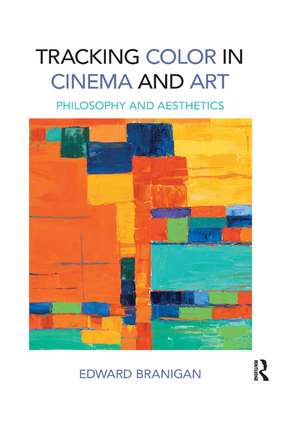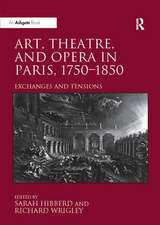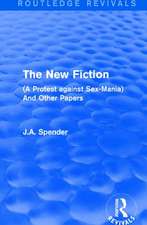Tracking Color in Cinema and Art: Philosophy and Aesthetics
Autor Edward Braniganen Limba Engleză Paperback – 30 sep 2020
Edward Branigan draws on the work of Ludwig Wittgenstein and other philosophers who struggle valiantly with problems of color aesthetics, contemporary theories of film and narrative, and art-historical models of analysis. Examples of a variety of media, from American pop art to contemporary European cinema, illustrate a theory based on a spectator’s present-time tracking of temporal patterns that are firmly entwined with language use and social intelligence.
| Toate formatele și edițiile | Preț | Express |
|---|---|---|
| Paperback (1) | 313.81 lei 3-5 săpt. | +31.39 lei 4-10 zile |
| Taylor & Francis – 30 sep 2020 | 313.81 lei 3-5 săpt. | +31.39 lei 4-10 zile |
| Hardback (1) | 813.41 lei 6-8 săpt. | |
| Taylor & Francis – 31 oct 2017 | 813.41 lei 6-8 săpt. |
Preț: 313.81 lei
Nou
Puncte Express: 471
Preț estimativ în valută:
60.05€ • 62.32$ • 50.20£
60.05€ • 62.32$ • 50.20£
Carte disponibilă
Livrare economică 24 februarie-10 martie
Livrare express 07-13 februarie pentru 41.38 lei
Preluare comenzi: 021 569.72.76
Specificații
ISBN-13: 9780367885052
ISBN-10: 0367885050
Pagini: 376
Dimensiuni: 174 x 246 x 26 mm
Greutate: 0.68 kg
Ediția:1
Editura: Taylor & Francis
Colecția Routledge
Locul publicării:Oxford, United Kingdom
ISBN-10: 0367885050
Pagini: 376
Dimensiuni: 174 x 246 x 26 mm
Greutate: 0.68 kg
Ediția:1
Editura: Taylor & Francis
Colecția Routledge
Locul publicării:Oxford, United Kingdom
Public țintă
Postgraduate and UndergraduateCuprins
Preface
1. Introduction and Overview
2. Living with Chromophilia
3. Stand or Track?
4. What's in White?
5. Making it Color-Full
6. Musical Hues: Color Harmony
7. Track this Color (in Place)
8. Track that Color (in Movement)
9. Summary
10. Conclusion
1. Introduction and Overview
2. Living with Chromophilia
3. Stand or Track?
4. What's in White?
5. Making it Color-Full
6. Musical Hues: Color Harmony
7. Track this Color (in Place)
8. Track that Color (in Movement)
9. Summary
10. Conclusion
Notă biografică
Edward Branigan is Professor Emeritus in the Department of Film and Media Studies at the University of California, Santa Barbara. He is the author of Projecting a Camera: Language-Games in Film Theory; Narrative Comprehension and Film; and Point of View in the Cinema: A Theory of Narration and Subjectivity in Classical Film. With Warren Buckland, he is the editor of The Routledge Encyclopedia of Film Theory. With Charles Wolfe, he is the general editor of the American Film Institute Film Readers series.
Recenzii
'This is an extraordinary achievement -- a major work (perhaps Branigan's most impressive yet) by one of our most important film theorists and philosophers. While color studies in film have exploded over the last fifteen years, most of the work has moved very cautiously and largely in a historicist fashion, one that privileges accounts of emerging technological innovations and to a lesser extent style at the expense of the fascinating perceptual questions color and color filmmaking raises. Branigan takes these questions head on and the results are positively stunning. It is the first book -- in film studies, at least -- to deal at great length and specificity with the question of color perception and color style. As I mentioned, most books shy away from stylistic analysis and the rich philosophical questions that color poses about perception and, as Branigan indicates very daringly, about how real the real world is.' -- Brian Price, University of Toronto
'Branigan takes a Wittgensteinian approach to color that "focuses not on what color is, but on how it functions, what it does for us, what we make of it." For our delectation, he offers us an extraordinarily rich and provocative feast that takes us beyond cinema to the uses and meanings of color in painting, philosophy and literature.' -- C.L. Hardin, Professor of Philosophy, Emeritus, Syracuse University. Author of Color for Philosophers: Unweaving the Rainbow (1993).
'Branigan takes a Wittgensteinian approach to color that "focuses not on what color is, but on how it functions, what it does for us, what we make of it." For our delectation, he offers us an extraordinarily rich and provocative feast that takes us beyond cinema to the uses and meanings of color in painting, philosophy and literature.' -- C.L. Hardin, Professor of Philosophy, Emeritus, Syracuse University. Author of Color for Philosophers: Unweaving the Rainbow (1993).
Descriere
This book develops a compelling framework from which to understand the mobility of color in art and mind, where color impressions are seen through, and even governed by, patterns of ordinary language use, schemata, memories, and narrative.

















